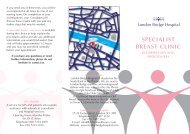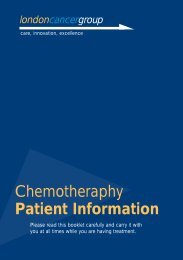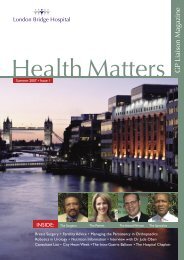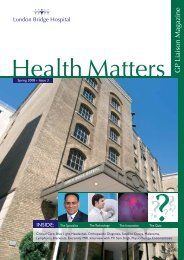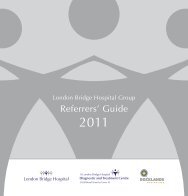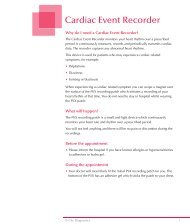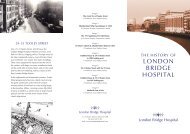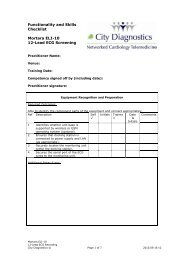Health Matters - London Bridge Hospital
Health Matters - London Bridge Hospital
Health Matters - London Bridge Hospital
- No tags were found...
Create successful ePaper yourself
Turn your PDF publications into a flip-book with our unique Google optimized e-Paper software.
Extracorporeal Shock Wave TherapyExtracorporeal ShockWave Therapy (ESWT) forSports Injury Treatmentby Dr Stephen Motto, Sports Injury DiagnosticsWhat is Extracorporeal ShockWave Therapy (ESWT)?Extracorporeal Shock Wave Therapy(ESWT) is a relatively new techniquethat uses shockwaves to treat chronicconditions of the musculoskeletal system.I have been using ESWT for nine years.It is the same technology used to treatpatients with kidney stones in the 1980swithout surgery (Lithotripsy). Thistreatment was subsequently applied to avariety of musculoskeletal conditions andthe technology was refined in the 1990s.I use a device called orthoPACE fromthe Pulsed Acoustic Cellular Expression(PACE) platform. This device generateselectrohydraulic shock waves thathave a biological activating effectwhich regenerates hard and softmusculoskeletal tissues such as bone,tendons and ligaments.orthoPACE utilises medium to highenergy acoustic or pressure waves tofocus treatment for tendinopathies,chronic bursitis, some cases of tibialperiostitis (‘shin splints’) and may helpwith delayed bone healing. The PACEprinciple involves the induction of cellularsignals and factors including increasedangiogenesis that promote healing inwounds and soft tissues.We are trying to convert a chronic injuryinto an acute one by mechanotransduction,working synergistically with exercisetherapy. It also complements otherenergy treatments provided, such asLaser needle, Pulsed Electromagnetictherapy and InterX (a sensory electricalneuro-stimulation device).What happens during ESWT?Treatment is carried out in the SportsInjury Diagnosis clinic at <strong>London</strong> <strong>Bridge</strong><strong>Hospital</strong> and takes about 20-30 minutes.The patient is usually able to return towork but should restrict activities duringthe first week. Follow-up examinationand treatment take place at four-sixweeks, although further treatment maynot be necessary. Treatment may not becovered by medical insurers.Many patients experience an improvementin symptoms almost immediately, whileothers take two-three weeks to respond.A few fail to respond with 10% or soexperiencing a transient aggravation.There may be a transient reddening orswelling of the area with some patientsexperiencing a brief increase in pain.Numbness or paraesthesia are lessfrequent side effects.Patient experiencesI recently presented some of myexperiences using shockwave therapyat the 2nd Congress of the EuropeanCollege of Sports and Exercise Physicians,9th-11th September 2010, at QueenMary, University of <strong>London</strong>.It is accepted that managing chronicpatella tendinopathy (‘Jumper’s knee‘),prevalent in 7%-40% of the athleticpopulation, is difficult with athletesexperiencing frequent setbacks andrecurrent pain and dysfunction formany months. Two papers have foundshockwave therapy to be of somesuccess (see References 1 and 2) for thiscondition, whereas in my hands the mostsuccessful areas are in the treatmentof plantar fasciitis, insertional Achillestendinopathy, calcific tendinopathy of theshoulder, quadriceps tendinopathy andonly of marginal benefit in tennis elbow.I hope the introduction of orthoPACE willaddress some of the shortcomings of itspredecessor (EvoTron). First impressionsare that it is less painful for the patient,who seems better able to toleratetreatment with the new device withoutlocal anaesthetics. The new applicatorfor orthoPACE delivers higher energydensities at more superficial depths. Thehope is that conditions such as patellatendinopathy and tennis elbow willrespond more favourably than with theEvoTron.A couple of successful applicationsof ESWT at Sports InjuryDiagnosis clinic:• A walker with a heel spur and aone-year history of heel pain.• A lady with Addison’s diseaseand chronic Achilles tendinopathypreventing her from working.Dr Stephen MottoBM Dip Sports MedD M-S Med Dip Med AcFFSEM (Ireland) FFSEM (UK)Sports &Musculoskeletal ConsultantDr Stephen Motto is a Sports& Musculoskeletal Consultantat Sports Injury Diagnosis, asports medicine clinic based atSt Olaf House in <strong>London</strong> <strong>Bridge</strong><strong>Hospital</strong>, with an additional clinicat 31 Old Broad Street.For further details aboutSports Injury Diagnosis, contactMrs Anne Sampson, PracticeManager, on:T: 020 7403 0330orthoPACE is one of a number oftreatments offered by Sports InjuryDiagnosis clinic at <strong>London</strong> <strong>Bridge</strong><strong>Hospital</strong>. I assure you that whilst thereis no danger of me swimming thechannel, or running in the <strong>London</strong>Marathon, I am committed to helpingelite and recreational athletes/patientsachieve their exercise and sporting goals.References1. Extracorporeal Shock Wave Therapy for patellar tendinopathy: a review of the literature. van Leeuwen, Zwerver, van den Akker-Scheek. BrJSportsMed 2009;43:163-1682. Extracorporeal Shock Wave for Chronic Patellar Tendinopathy. Wang et al. Am J Sports Med June 2007; 35: 972-978SIXExtracorporeal Shock Wave Therapy



